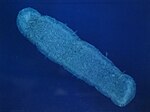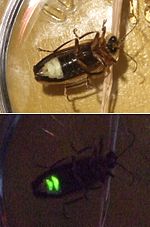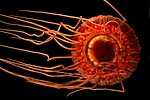Bioluminescence is the production and emission of light by living organisms. It is a form of chemiluminescence. Bioluminescence occurs widely in marine...
75 KB (8,096 words) - 09:16, 17 August 2024
Bioluminescence imaging (BLI) is a technology developed over the past decades (1990's and onward).[when?] that allows for the noninvasive study of ongoing...
14 KB (1,585 words) - 12:26, 5 September 2024
Foxfire (redirect from Foxfire (bioluminescence))
Foxfire, also called fairy fire and chimpanzee fire, is the bioluminescence created by some species of fungi present in decaying wood. The bluish-green...
6 KB (501 words) - 08:48, 18 September 2024
Aliivibrio fischeri (section Bioluminescence)
bacterium is a key research organism for examination of microbial bioluminescence, quorum sensing, and bacterial-animal symbiosis. It is named after...
26 KB (2,612 words) - 00:54, 16 September 2024
Stomiidae (section Bioluminescence in Stomiidae)
that can produce their own light through a chemical process known as bioluminescence. A special organ known as a photophore helps produce this light. The...
29 KB (3,339 words) - 19:00, 27 August 2024
that glow through bioluminescence. They include the European common glow-worm and other members of the Lampyridae, but bioluminescence also occurs in the...
9 KB (906 words) - 07:14, 2 August 2024
possess photophores, luminous organs, and exhibit intrinsic bioluminescence. Bioluminescence evolved once in Squaliformes, approximately 111–153 million...
13 KB (819 words) - 09:30, 1 May 2024
Noctiluca scintillans (section Bioluminescence)
when in this 'phase' of bioluminescence, so this may be one of the functions of bioluminescence. The function of bioluminescence has not yet been proven...
30 KB (3,598 words) - 15:20, 26 June 2024
bioluminescence is an honest aposematic warning signal to predators. Light production in fireflies is due to the chemical process of bioluminescence....
41 KB (3,955 words) - 00:27, 17 September 2024
Motyxia (section Bioluminescence)
have the ability to glow brightly: some of the few known instances of bioluminescence in millipedes. Adult Motyxia reach 3 to 4 cm in length, 4.5 to 8 mm...
20 KB (1,899 words) - 03:54, 9 September 2024
Malacosteus niger (section Red bioluminescence)
to produce both red and blue bioluminescence. Most mesopelagic species aren't capable of producing red bioluminescence. This is advantageous because...
15 KB (1,863 words) - 00:06, 3 June 2024
Panellus stipticus (section Bioluminescence)
of the gills and the junction of the gills with the stem and cap. Bioluminescence is also observable with mycelia grown in laboratory culture, and the...
56 KB (5,878 words) - 01:13, 18 May 2024
excitation of the acceptor or to photobleaching. To avoid this drawback, bioluminescence resonance energy transfer (or BRET) has been developed. This technique...
52 KB (6,145 words) - 10:08, 6 January 2024
Pyrosome (section Bioluminescence)
"body". Although many planktonic organisms are bioluminescent, pyrosome bioluminescence is unusual in its brilliance and sustained light emission, and evoked...
10 KB (991 words) - 21:04, 10 August 2024
Omphalotus nidiformis Bioluminescence is the production of light by living organisms. This list of bioluminescent organisms is organized by the environment...
11 KB (798 words) - 20:35, 2 July 2024
Filoboletus manipularis (section Bioluminescence)
fruiting body, or none of the fruiting body displaying bioluminescence. When bioluminescence is observed, the fruiting body emits typically 595 photons...
9 KB (873 words) - 22:54, 22 February 2024
Luciferase (category Bioluminescence)
is a generic term for the class of oxidative enzymes that produce bioluminescence, and is usually distinguished from a photoprotein. The name was first...
27 KB (2,896 words) - 20:19, 27 June 2024
Arachnocampa luminosa (section Bioluminescence)
to New Zealand. The larval stage and the imago produce a blue-green bioluminescence. The species is known to dwell in caves and on sheltered banks in native...
13 KB (1,475 words) - 21:19, 20 June 2024
Slendertail lanternshark (section Bioluminescence)
implies that there is a limit to how beneficial the slendertail's bioluminescence is at higher depths, limiting the sharks movement up the water column...
12 KB (1,292 words) - 12:17, 2 April 2024
in living cells. No correlation of fungal bioluminescence with cell structure has been found. Bioluminescence may occur in both mycelia and fruit bodies...
55 KB (3,274 words) - 04:03, 18 September 2024
fundamental and applied aspects of all forms of luminescence, including bioluminescence, chemiluminescence, electrochemiluminescence, sonoluminescence, triboluminescence...
4 KB (292 words) - 19:21, 30 April 2023
Bioluminescent bacteria (category Bioluminescence)
fish and in the gut of marine animals. While not as common, bacterial bioluminescence is also found in terrestrial and freshwater bacteria. These bacteria[clarification...
40 KB (4,505 words) - 10:42, 17 August 2024
process by which bioluminescence is created is very similar to what happens when a glow stick is broken. Deep-sea organisms use bioluminescence for everything...
5 KB (588 words) - 09:19, 25 June 2024
Atolla jellyfish (section Bioluminescence)
may be floating nearby. Bioluminescence is the production of visible light by a living organism (Herring 2004). Bioluminescence is a common phenomenon...
7 KB (893 words) - 18:06, 27 August 2024
Firefly squid (section Bioluminescence and vision)
unclear in the scientific community exactly how this species uses their bioluminescence. The firefly squid is a predator and actively hunts its food, which...
25 KB (2,810 words) - 15:55, 10 September 2024
Vargula hilgendorfii (section Bioluminescence)
water. At night, it feeds actively. V. hilgendorfii is known for its bioluminescence. It produces a blue-coloured light by a specialized chemical reaction...
6 KB (682 words) - 04:11, 5 February 2024
Pyrocystis fusiformis (section Bioluminescence)
reaching lengths of up to 1 millimetre (0.039 in). P. fusiformis display bioluminescence when disturbed or agitated. In coastal marine waters, this dinoflagellate...
15 KB (1,659 words) - 01:32, 19 May 2024
Siphonophorae (section Bioluminescence)
attract and attack prey. While many sea animals produce blue and green bioluminescence, a siphonophore in the genus Erenna was only the second life form found...
32 KB (3,546 words) - 06:46, 27 August 2024
in the water column. E. Newton Harvey had noted the unusual yellow bioluminescence occurring from the parapodia. There are very few known marine animals...
4 KB (287 words) - 14:40, 14 October 2023
Peter J. (1987). "Systematic distribution of bioluminescence in living organisms". Journal of Bioluminescence and Chemiluminescence. 1 (3): 147–163. doi:10...
3 KB (144 words) - 12:40, 31 May 2024




























